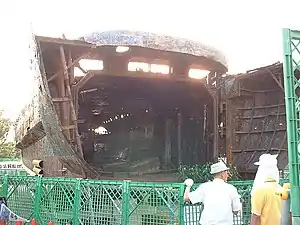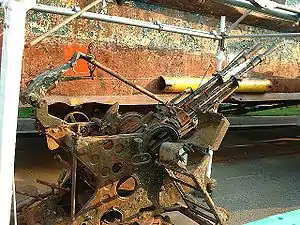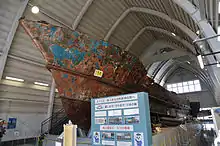Fushin-sen
Fushin-sen (不審船 or ふしんせん, eng. suspicious ship) is a Japanese term that generally refers to all seaborne vessels that behave suspiciously.

In Japan, it is used to often refer to seacraft vessels of the Democratic People's Republic of Korea (North Korea), which are often witnessed in the waters near Japan, and suspected of being used for poaching or smuggling by criminal elements. Since the official confirmation of the first "fushin-sen" in 1963, the Japan Coast Guard has confirmed that 20 cases and 21 suspicious ships by 2003.[1]
North Korean fushin-sen
The North Korean sea vessels have become the dark bridge that connects the Yakuza and North Korean criminal elements, and the term fushin-sen has become synonymous with such North Korean seacraft. In addition to being used as a means of smuggling agents and illegal immigrants, there are many incidents of fushin-sen being involved in drug smuggling and the abduction and trafficking of Japanese people. According to a discourse issued at a press conference by the former Secretary of the Public Security Intelligence Agency, criminal elements such as organized crime and front companies are suspected of having used fushin-sen as a means of supplying drugs to Yakuza, as they already have connections with North Korean agents and its institutions.[2]
The fushin-sen are utilized by a special unit with the North Korean regime, and the operatives on board are selected from the North Korean top-ranking people. The operatives are not only good at various combat tactics such as sniping and Gjogsul, but also have advanced language skills to impersonate the citizens of the chosen country for infiltration and to establish permanent residency as part of public. The operatives who smuggled into Japan by seacraft are usually concealed by related parties and blend in with the region as members of society, but when orders are given from their home countries, they use friendships as a foothold and carry out human intelligence. Such operatives may coerce Japanese to carry out criminal activities for them. In Japan, several such operatives have been wanted internationally by Interpol.[3]
The Japanese police and the Coast Guard are actively working to educate civilians about the fushin-sen issue and the dangers they pose to public safety. At prefectural police headquarters and police stations located around the coastal areas have been conducting active seminars for companies and fishermen since the 1950s. It has not always been possible to prevent the abduction of Japanese people and the smuggling of agents. The Japan Coast Guard recommends that citizens call 118 (telephone number for emergency calls for incidents and accidents at sea in Japan) if a person witnesses a suspicious ship that appears to be of North Korean origin.[4][5]
Features
This list describes a fushin-sen/suspicious ship that maybe of North Korean origin. The following features can be mentioned as points of focus for discovering about fushin-sen/suspicious ships:[6]

- Disguised as a Japanese or Chinese fishing vessel. Alternatively, a North Korean cargo ship may be used as a one.
- Equipped with a large number of antennas, such as shortwave radios, that improve signal of wireless equipment.
- The radar installed on the mast may be set higher than a normal fishing boat to quickly detect the approach of Japanese navy vessels and/or fishery patrol boats and take evasive action.
- No fishing gear is mounted on the bow, or even if it is mounted, there is no evidence that it has been used.
- Inside the ship, there is a small high-speed boat for landing that looks like a small fishing boat that is often seen in the coastal areas of Japan, and there is a door at the stern for putting it in and out. On the other hand, when infiltrating South Korea, a special boat called "semi-submersible" will be installed. This is because in South Korea, if a suspected spy ship attempts to escape, the ROK Navy will sink the suspected ship as well as the suspect.
- The lights are completely turned off, and the operatives try to smuggle in from the beach, which is hidden in the darkness. Alternatively, berth the ship at a fishing port in a depopulated area so as to avoid the public eye.
- Weapons are hidden inside the ship. An investigation into the North Korean vessel used in Spy Ship Incident in the Southwest Sea of Kyūshū revealed that it was equipped with a large number of weapons, including anti-aircraft weapons and anti-tank weapons.
- It is equipped with a powerful diesel engine introduced from other countries such as Russia, and has 10 times the horsepower and twice the speed of fishing boats of the same type. This enables high-speed navigation equal to or higher than that of warships. However, when a research team at the Japan Coast Guard Academy inspected a suspicious ship that was pulled up during the Battle of Amami-Oshima in the southwestern part of Kyushu, it seems that the speed will drop significantly in bad weather with a wave height of 3 meters or more.
- In order to accept operatives and smuggled goods, the base person (North Korean contact) may board a vehicle such as a rental car on the beach at midnight and communicate with a suspicious ship offshore by a light emitting signal or a mobile phone. In particular, it is said that freight vehicles such as cold storage vehicles and aluminum vans are preferred as vehicles that are convenient for accepting multiple smugglers and transporting stimulants.
- There is also possibility that legally recognized North Korean cargo ships and ferries maybe used as fushin-sen. One such example has been the Man Gyong Bong 92.[7][8][9]
Encounters
Niigata JRCS Center Bombing Attempt
(December 4, 1959) The South Korean government conducted a joint return project for Koreans in Japan with the Japanese Red Cross Society, in response the North Korean government and Koreans in Japan jointly carried out terrorist activities, such as the bombing of trains and ships in Japan and the abductions of important people.
Kidnapping of Kim Dae-jung
(August 8, 1973) An incident in which Kim Dae Jung, who was staying in Japan, was abducted by an agent of the Korean Central Intelligence Agency and a Korean resident in Japan, and was taken to South Korea by a craft.
Suspicious ship off the coast of Noto Peninsula
(March 23, 1999) A ship believed to be a North Korean craft ship appeared off the Noto Peninsula in the Sea of Japan, and was tracked by the Japan Coast Guard and the Maritime Self-Defense Force. For the first time, the Maritime Self-Defense Force was issued a maritime security action, which is a de facto actual battle order (security operation). As a result, the craft ship was missed, but this incident triggered the realization of hull shooting and the maintenance of patrol boats due to the revision of the Japan Coast Guard Law, and the formation of the Maritime Self-Defense Force's Special Boarding Unit and on-site inspection team with escort vessels.
Kyushu Southwest Sea Area Fushin-sen Incident (Battle of Amami-Ōshima)

(December 22, 2001) A North Korean craft ship appeared in the East China Sea off the southwest coast of Kyushu, and was tracked by the Japan Coast Guard and the Maritime Self-Defense Force. After pursuing, a cornered craft ship shoots a Japan Coast Guard patrol boat. A patrol boat was hit and three coast guard officers were injured. The patrol boat immediately carried out self-defense shooting, and it became a shooting battle. The craft ship self-destructed during the shootout and sank in an instant. At this time, all the operatives died.
Other incidents
- Suspicious ship off the coast of Kaga City (July 31, 1971)
- Hyuga Nada Suspicious Ship Case (April 25–27, 1985)
- Suspicious Ship Case in Central Sea of Japan (September 4, 2002 – September 5, 2002)
- Mihama Incident (October 28, 1990): An incident in which a small boat for landing was washed ashore on the coast of Mihama-cho, Mikata-gun, Fukui Prefecture (see the external link for details).
- North Korean semi-submersible sinking incident (December 18, 1998): A suspicious ship found by South Korean coastal guards invading South Korean waters goes to Tsushima, Nagasaki Prefecture to escape the pursuit of the South Korean Navy. When the South Korean Navy was pursuing the invasion, an incident occurred in which it was sunk on the open sea 70 km off Tsushima. A later pull-up investigation revealed that the suspicious ship was a North Korean semi-submersible. Until March 1999, the Japan Coast Guard strengthened vigilance off the coast of Tsushima and provided crime prevention guidance to residents of Tsushima and the Goto Islands.
See also
- North Korea's illicit activities
- Japan–North Korea relations
- Violations of Japanese airspace
- Japan Maritime Self-Defense Force and Scrambling (military)
- North Korean abductions of Japanese citizens
- Man Gyong Bong 92
- Pong Su incident
- 1996 Gangneung submarine infiltration incident
- Defection of Viktor Belenko
- Semi-submersible platform
- USS Pueblo (AGER-2)
- Unidentified flying object
External links
References
- Maritime Security Study Group, "Books for Understanding North Korean Craft Ships", 2004, Narishando Bookstore ISBN 4-425-53091-8
- Osamu Eya, "North Korea's Infiltration Work Against Japan" --What is the purpose of the suspicious ship? , Takarajimasha, 2002 ISBN 4796628975
- Osamu Eya, "North Korea's Infiltration Work Against Japan" --What is the purpose of the suspicious ship? , Takarajimasha, 2002 ISBN 4796628975
- Jinnet North Korea Problem Coverage Group, "Tracking! !! Complete Illustrated North Korean Craft Ship Structure and Operations ”, Shogakukan, 2000 ISBN 409404471X
- Maritime Security Study Group, "Books for Understanding North Korean Craft Ships", 2004, Narishando Bookstore ISBN 4-425-53091-8
- http://www.kaiho.mlit.go.jp/info/news/h14/fushinsen/index.html
- "North Korean Supporters in Japan: Issues for U.S. Policy" (PDF). 2009-07-09.
- Buckley, Sarah (2003-06-09). "N Korea ferry struggling against the tide". BBC News. Retrieved 2010-06-15.
- Shipper, Apichai W. (2010). "Nationalisms of and against Zainichi Koreans in Japan". The Washington Times. doi:10.1111/j.1943-0787.2009.01167.x.